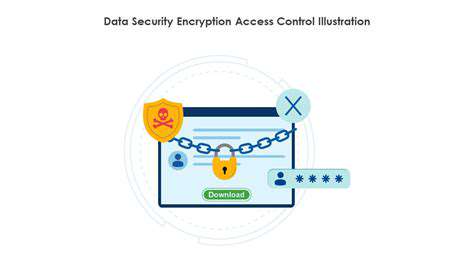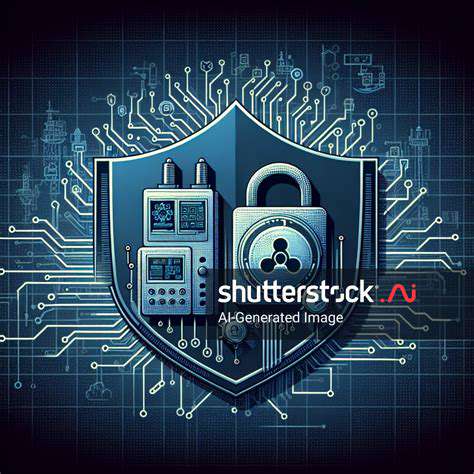Best Practices for Securing Mobile Apps (Development & Usage)

Data Encryption Techniques
Data encryption is a fundamental aspect of data protection. It involves transforming readable data into an unreadable format, known as ciphertext, to prevent unauthorized access. Various encryption algorithms, such as AES and RSA, are employed to achieve this transformation. These algorithms use complex mathematical formulas to ensure data confidentiality, making it virtually impossible for unauthorized individuals to decipher the information without the proper decryption key. Different encryption techniques cater to diverse needs and security requirements.
Access Control Mechanisms
Robust access control mechanisms are crucial to limit access to sensitive data. These mechanisms control who can access specific data and what actions they can perform on it. Implementing strong passwords, multi-factor authentication, and role-based access control are key components of effective access control. Restricting access based on user roles and permissions minimizes the risk of unauthorized data modification or leakage. This granular control significantly enhances the overall security posture.
Data Loss Prevention (DLP) Systems
Data Loss Prevention (DLP) systems play a vital role in safeguarding sensitive data. These systems monitor data in transit and at rest, identifying and preventing unauthorized data leakage. DLP tools can detect sensitive information leaving the organization's network or being copied to unauthorized locations. DLP solutions often combine various techniques, including data masking, encryption, and access control, to achieve comprehensive protection. Proactive DLP measures can minimize the risk of data breaches and associated consequences.
Regular Security Audits and Assessments
Regular security audits and assessments are critical for ensuring the effectiveness of data protection strategies. These assessments evaluate the current security posture, identify vulnerabilities, and recommend improvements. Audits help organizations understand their strengths and weaknesses in data protection and provide a framework for continuous improvement. They often involve penetration testing, vulnerability scanning, and security awareness training to assess the organization's preparedness against potential threats.
Data Backup and Recovery Procedures
Comprehensive data backup and recovery procedures are essential for disaster recovery and business continuity. These procedures ensure that critical data can be restored in case of data loss due to various events, such as hardware failure, natural disasters, or cyberattacks. Implementing a robust backup strategy minimizes data loss and downtime, ensuring business continuity in challenging situations. Regular testing of backup and recovery procedures is crucial for maintaining their effectiveness.
Employee Training and Awareness Programs
Employee training and awareness programs are critical components of a successful data protection strategy. Educating employees about data security best practices and potential risks is paramount to minimizing human error. Training programs should emphasize the importance of strong passwords, phishing awareness, and safe handling of sensitive data. Regular updates and reinforcement of these programs are vital to maintain a strong security culture within the organization. Promoting a security-conscious culture prevents unintentional data breaches.
Data Retention Policies and Procedures
Data retention policies and procedures define how long sensitive data should be stored and the methods for securely disposing of it. These policies ensure compliance with regulations and minimize the risk of data breaches. Establishing clear guidelines for data retention and disposal prevents unauthorized access to outdated data. Properly managing data retention reduces storage costs and enhances data security. These policies should be regularly reviewed and updated to meet evolving regulatory requirements.
Robust Authentication and Authorization Mechanisms

Robust Authentication Mechanisms
Robust authentication is a cornerstone of any secure system, ensuring that only authorized users gain access to sensitive data and resources. Implementing strong authentication methods is crucial for preventing unauthorized access and protecting against various security threats, like credential stuffing and phishing attacks. This involves using multi-factor authentication (MFA) where possible, employing strong password policies, and regularly auditing user accounts for suspicious activity.
Various authentication methods exist, ranging from simple username/password combinations to more complex approaches like biometric verification. Choosing the appropriate authentication method depends on the specific security needs and the level of risk tolerance. The selection of authentication methods should also take into account the user experience and the potential impact on system usability.
Authorization Policies
Authorization policies define the specific permissions and access rights granted to authenticated users. These policies dictate what actions users are allowed to perform on the system, such as reading files, modifying data, or executing specific commands. Effective authorization controls are essential for maintaining data integrity and confidentiality.
Implementing fine-grained access control is critical. This allows administrators to precisely define what each user can access, minimizing the potential damage from a security breach. This granular control is vital in preventing unauthorized access and data breaches.
Security Best Practices
Adhering to established security best practices is critical for creating a robust authentication and authorization system. This includes regularly updating software and libraries to patch known vulnerabilities, implementing intrusion detection systems, and conducting regular security audits.
Security awareness training for all users is also extremely important. Educating users about common security threats and best practices can significantly reduce the risk of human error. This includes recognizing phishing attempts and understanding the importance of strong passwords.
User Management
Efficient user management plays a vital role in maintaining the security and integrity of the system. This encompasses creating, modifying, and deleting user accounts, managing access privileges, and tracking user activity. A well-defined user management process ensures that only authorized personnel can access sensitive data.
Auditing and Monitoring
Regular auditing and monitoring of user activity are essential for detecting and responding to security incidents. Auditing logs record user actions, providing a historical record of activity. This historical record is invaluable for identifying patterns, investigating security breaches, and maintaining compliance requirements.
Monitoring user activity in real-time allows for rapid identification of suspicious behavior. This proactive approach helps prevent unauthorized access and mitigate the impact of security breaches. The ability to react quickly to threats is crucial in today's rapidly evolving threat landscape.
Scalability and Performance
A robust authentication and authorization system must be designed with scalability and performance in mind. The system should be able to handle a large number of concurrent users and requests without degrading performance. This is critical for ensuring that the system can meet the demands of a growing user base.
Efficient algorithms and optimized database queries are vital for maintaining responsiveness. These considerations ensure a smooth user experience and prevent performance bottlenecks that could compromise security.
Protecting Against Malicious Attacks: Vulnerability Management
Identifying Potential Vulnerabilities
A crucial first step in protecting against malicious attacks is identifying potential vulnerabilities within your systems and applications. This involves a comprehensive assessment of all software components, configurations, and network structures. Thorough vulnerability scanning, utilizing automated tools and manual reviews, is essential to pinpoint weaknesses that could be exploited. This proactive approach allows organizations to address potential threats before they become actual incidents, minimizing the risk of data breaches and system compromises.
Implementing Robust Security Controls
Once vulnerabilities are identified, implementing robust security controls is paramount. This includes employing strong access controls, enforcing multi-factor authentication, and regularly updating software and systems with the latest security patches. By establishing and maintaining these controls, organizations significantly reduce the attack surface and make it more challenging for malicious actors to gain unauthorized access.
Implementing firewalls, intrusion detection systems (IDS), and intrusion prevention systems (IPS) are further crucial security controls. These systems monitor network traffic for malicious activity and either block or alert administrators to potential threats. These proactive measures significantly enhance the overall security posture.
Regular Security Audits and Assessments
Regular security audits and assessments are vital for maintaining a strong security posture. These assessments should cover both the technical infrastructure and the security policies and procedures. They help organizations identify any gaps in their security controls and ensure that they are effectively mitigating risks.
A thorough security audit will evaluate the effectiveness of existing security measures, identify any misconfigurations, and uncover potential areas for improvement. This process is crucial for staying ahead of evolving threats and maintaining a proactive security approach.
Employee Training and Awareness
Human error often plays a significant role in security breaches. Therefore, employee training and awareness programs are essential components of any comprehensive security strategy. Employees need to be educated on recognizing phishing attempts, avoiding suspicious links and attachments, and reporting potential security incidents promptly. This empowers them to become active participants in maintaining the security of the organization.
Incident Response Planning
Having a well-defined incident response plan is crucial for mitigating the impact of security breaches. This plan should outline the steps to be taken in the event of a security incident, including notification procedures, containment strategies, and recovery protocols. A comprehensive incident response plan ensures a coordinated and effective response to any security event, minimizing the damage and facilitating a quick recovery.
Continuous Monitoring and Improvement
Security is an ongoing process, not a one-time event. Continuous monitoring of systems and networks is essential for detecting and responding to emerging threats. This includes monitoring security logs, analyzing network traffic, and staying informed about the latest security threats and vulnerabilities. Regular reviews and updates to the security plan and procedures are also necessary to ensure that the organization's defenses remain effective against evolving threats.
User Education and Awareness: Fostering Secure Usage Habits
Understanding the Importance of Security
User education and awareness are crucial components of a robust security posture. Individuals often underestimate the potential risks associated with online activities, from simple browsing to complex financial transactions. Understanding these risks and the importance of secure practices is the first step toward preventing security breaches and protecting sensitive information. A well-informed user is a more secure user, and proactive measures are far more effective than reactive ones.
Recognizing Common Threats
Users need to be aware of the diverse range of threats they face online. This includes phishing scams, malware infections, social engineering tactics, and data breaches. Phishing emails and text messages often appear legitimate, tricking users into revealing personal information or downloading malicious software. It's essential to develop a healthy skepticism and to verify the authenticity of any communication asking for sensitive data.
Furthermore, understanding how malware can infiltrate systems and the potential consequences of compromised accounts is vital. Users must be vigilant about the sources of downloads, the websites they visit, and the emails they open.
Creating Strong Passwords and Managing Accounts
Strong passwords are fundamental to online security. Users should avoid easily guessable passwords and instead create unique, complex passwords for each account. Implementing password managers can help mitigate the risk of weak or reused passwords, safeguarding accounts from unauthorized access. Multi-factor authentication (MFA) should be enabled wherever possible to add an extra layer of security.
Account management is equally important. Regularly reviewing account settings, monitoring for suspicious activity, and promptly reporting any security breaches are essential practices.
Safe Browsing Practices and Recognizing Phishing Attempts
Users should be encouraged to practice safe browsing habits, such as verifying website security (HTTPS), avoiding suspicious links, and being cautious about downloading files from untrusted sources. Learning to recognize phishing attempts is paramount. Phishing emails and websites often contain subtle but important clues that indicate they are fraudulent, such as poor grammar, misspellings, or unusual requests for personal information.
Protecting Sensitive Information and Data
Protecting sensitive personal information, such as financial details, social security numbers, and medical records, is crucial. Users should understand how to securely store and transmit this data, employing strong encryption methods when necessary. Understanding data privacy policies and regulations, like GDPR, is also essential to make informed decisions about sharing personal information online.
Staying Updated on Security Best Practices
The digital landscape is constantly evolving, and new security threats emerge regularly. Staying informed about the latest security best practices and vulnerabilities is vital. Regularly updating software, employing anti-malware protection, and participating in security awareness training are all proactive steps to enhance online security. Following reputable security blogs, news outlets, and social media channels can help keep users abreast of current threats and best practices.
Read more about Best Practices for Securing Mobile Apps (Development & Usage)
Hot Recommendations
- Review: The New [Specific Brand] Smart Lock Is It Secure?
- Best Budget Studio Monitors for Music Production
- Top Flight Simulation Peripherals (Joysticks, Throttles, etc.)
- Top Portable Scanners for Document Management On the Go
- Reviewing the Latest Smart Air Purifiers for Your Home
- Best Portable Photo Printers for Travelers and Memory Keepers
- The Future of Personal Transportation Beyond Cars (Hyperloop, eVTOL)
- Top Network Monitoring Tools [Free & Paid Options]
- Understanding the Tech Behind mRNA Vaccines [A Look Inside]
- Guide to Choosing the Right Gaming Chair for Ergonomics
![Is the Metaverse the Next Internet? [Analysis]](/static/images/25/2025-05/BuildingBlocksandBarriers3ATechnologicalChallengesandOpportunities.jpg)
![What is the Internet of Things (IoT)? [Simple Explanation]](/static/images/25/2025-05/TheFutureofIoT3AOpportunitiesandChallenges.jpg)
![How to Automate Your Workflow with [Automation Tool]](/static/images/25/2025-05/OptimizingYourZapsforEfficiency.jpg)







![How to Use [Software] for Project Gantt Charts & Scheduling](/static/images/25/2025-06/AdvancedSchedulingTechniques26Reportingin5BSoftware5D.jpg)
